On Saturday, I marched with the Queer Bloc of the National March on Washington to Free Palestine—a fitting contingent to accompany, given I largely started writing about Israel by way of reporting on the intersection of LGBTQ rights and Palestinian freedom in 2010.
There was no formal leader to the bloc; queer and trans people were simply told to meet in front of the Old Post Office on Pennsylvania Avenue if we wanted to march with other queers. It was a motley crew, but the first things I observed were that there was no rainbow branding—the only flags I saw all day were red, white, black and green— and I noticed how many signs fundamentally rejected “pinkwashing” without even needing to name what it is.
Pinkwashing is the phenomenon by which countries like the United States and Israel declare themselves superior to Palestine because of their treatment of LGBTQ people. But this faux-moral superiority pinkwashes the ways LGBTQ Palestinians are not welcome in Israel (nor, increasingly, in the United States), and it tries to hide the brutality of their lives under apartheid even before October 7. And as if their own governments and religious zealots don’t enact lethal homophobia and transphobia, Israel and the United States’s pinkwashing condemns Palestine as inherently homophobic and transphobic.
As I recently heard Queer Palestine and the Empire of Critique author Sa’ed Atshan say in a talk, pinkwashing falsely presumes not only that LGBTQ life doesn’t exist in Palestine but that LGBTQ Palestinians aren’t ever affirmed by their families or each other. And much as feminism is necessary, Atshan argues, queerness is fundamental to imagining a free Palestine into being.
Perhaps most relevant to the ceasefire the Queer Bloc marched for this weekend, pinkwashing obscures how LGBTQ people are being tortured, starved, and killed daily by the Israeli Occupation Forces. If just five percent of the 2.3 million people in Gaza are LGBTQ, that means at least 115,000 of queer Palestinians are being directly terrorized right now and about 500 have been killed (to say nothing of their families). This has been most heartbreakingly documented by people in Gaza using Queering the Map, a community-generated platform that “provides an interface to collaboratively record the cartography of queer life—from park benches to the middle of the ocean—in order to preserve our histories and unfolding realities, which continue to be invalidated, contested, and erased.”
In Gaza, queer people have been using it to honor their dead, post what they imagine to be their final messages before their own deaths, and make promises to find each other in the afterlife. Queer theory and contemporary gay life were formed in the shadow of death caused by AIDS in 1980s; now, queer people in Gaza are living in a far more urgent shadow of death—one in which the grim reaper won’t come in the form of HIV killing them over years, but in an instant, when a bomb is dropped from one of the American made jets or drones constantly flying over Gaza.
However, because they are Palestinians, pinkwashing tries to erase the need for their safety from the global LGBTQ community.
The marchers on Saturday weren’t having it, carrying signs with slogans like “Faggots for a Free Palestine,” “Trans Women for Palestine,” “Gaysians for Palestine,” and “Just another angry Black homosexual journalist for a free press in a free Palestine.” (Ok, that last one was mine.) These messages all rejected pinkwashing without even bothering to denounce it.
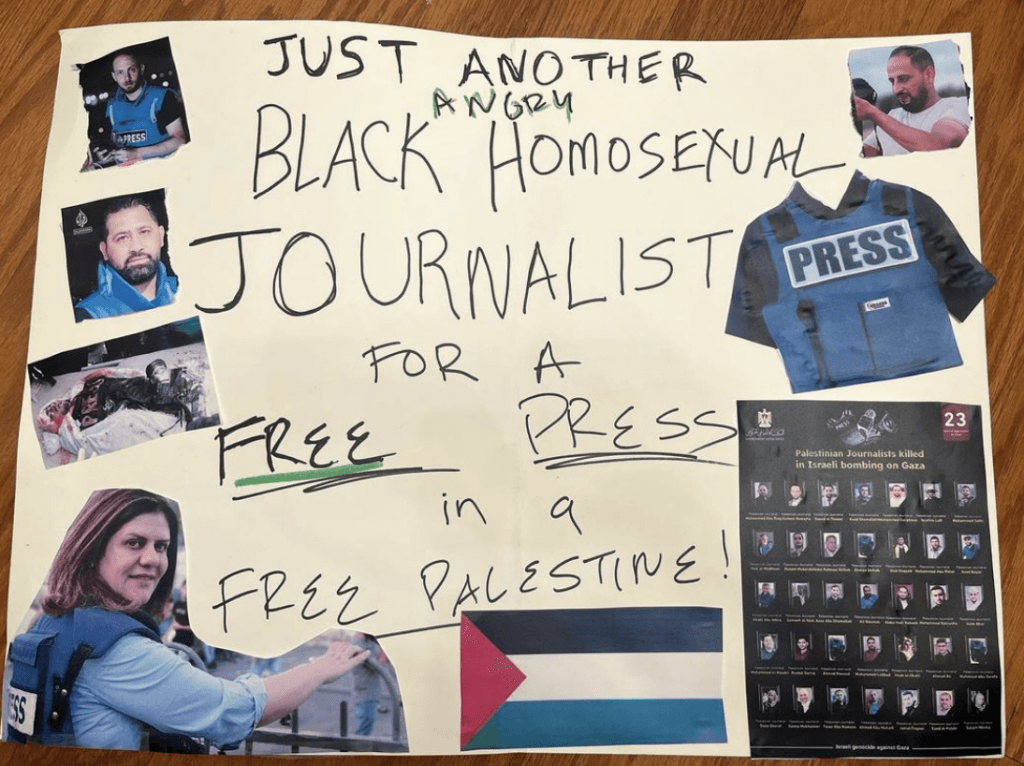
One sign, “Queers Against Israeli Apartheid,” stood out to me. When I was a Village Voice reporter in 2012, a group by the same name was banned from meeting at New York’s LGBT Center, after Zionist pornographer Michael Lucas organized wealthy donors to demand their ouster. Some of those protesting the eviction were Jewish lesbians Judith Butler, Sarah Schulman, and Sherry Wolf.
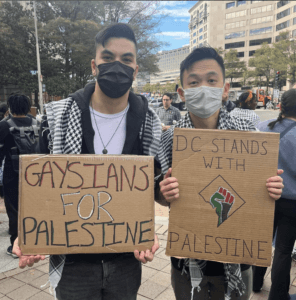
As the march finally began moving, I walked alongside a colleague I ran into, the performance studies scholar James McMaster, who was carrying the “Gaysians for Palestine” sign. When the Queer Bloc began to meld in with everyone else, James’sign fit nicely with sometimes harrowing, often playful anti-colonial signs which people of all ethnicities, nationalities, races, religions and sexualities carried.
I was hoping the route would pass directly in front of the White House, but it turned right a block away, at Lafayette Park. As we rounded the corner, we came upon two sights that will stay with me for the rest of my days: a group carrying a banner with the names of murdered Palestinian children (that was almost a block long), and a group of women clutching small wrapped dead children, in effigy. Like a rock in a stream, the women sat still in the middle of 14th Street, and made thousands of people bear witness and they passed around them.
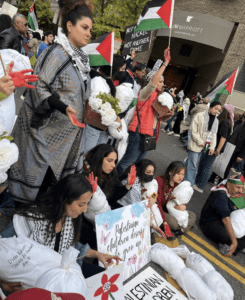
Shortly after that, I bumped into Sherry Wolf, one of the lesbians I’d interviewed a dozen years ago about the LGBT Center’s Palestine ban, holding a sign that said “Another Jew for a Free Palestine.”A dozen years later, she was still at it.
By this time, the Queer Bloc was dissolving into the great river of bodies, and I peeled off the route into McPherson Square to find Roy Edroso, another reporter friend covering the march. The park had been turned into a most beautiful, impromptu space of prayer, with dozens of Muslims who locked arms, kneeled down together, and prayed towards the east.
As I watched the route go by for a while, I realized that long after the Queer Bloc had moved on, there were still queer signs popping up throughout the march. No matter how many millions Israel spends on pinkwashing public relations campaigns, as an oppressed group—and like a majority of the American public even most Republicans—queer folks sympathize with the Palestinian people.
And queer folks are as integrated into the movement for a free Palestine as we are integrated into every other social movement. I found myself thinking of Bayard Rustin organizing the March of Washington for Jobs and Freedom in 1963, and also back to just last month, when Jewish Voices for Peace shut down Grand Central Terminal. Rustin was gay, and many of the organizers of the JVP protest were queer. Indeed, the Grand Central action was based on a 1991 ACT UP shutdown of the same space to demand more AIDS funding, and one when ACT UP interrupted a 1991 CBS Evening News broadcast with the call to “Fight AIDS, not Arabs!” on the eve of Gulf War.
“Fight AIDS, not Arabs”—that anticolonial slogan is still relevant today, and the shared struggle for queer liberation and a free Palestine are more interdependent than ever.
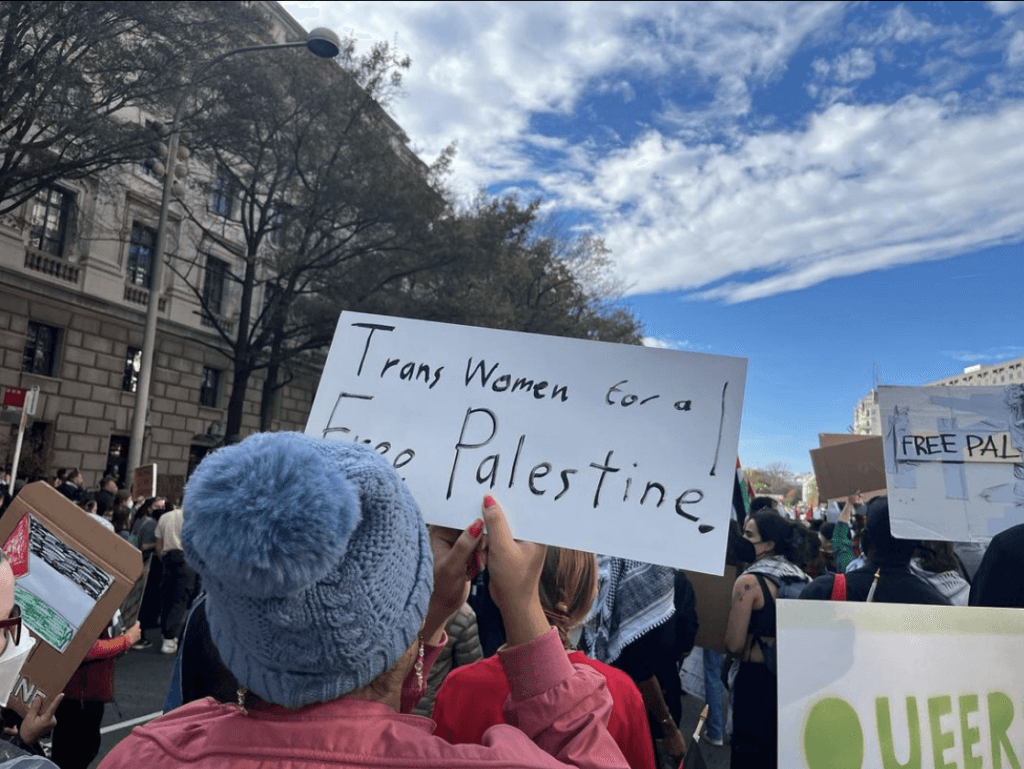
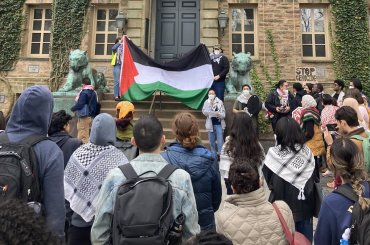
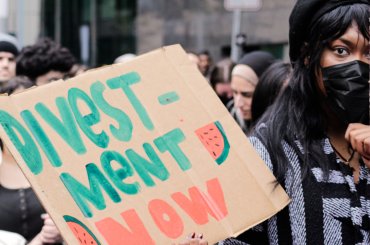
The satire is pretty accurate. Queers who support Hamas have been compared to chickens who support KFC.
https://www.youtube.com/watch?v=rbfccVBo9tE&ab_channel=%D7%90%D7%A8%D7%A5%D7%A0%D7%94%D7%93%D7%A8%D7%AA